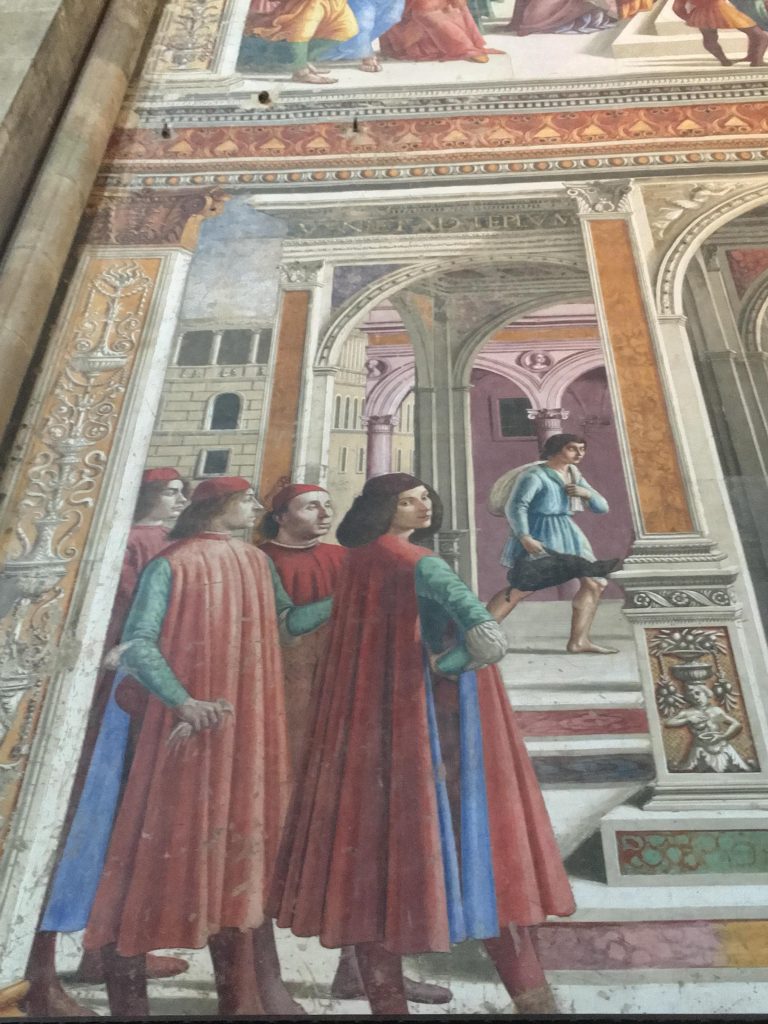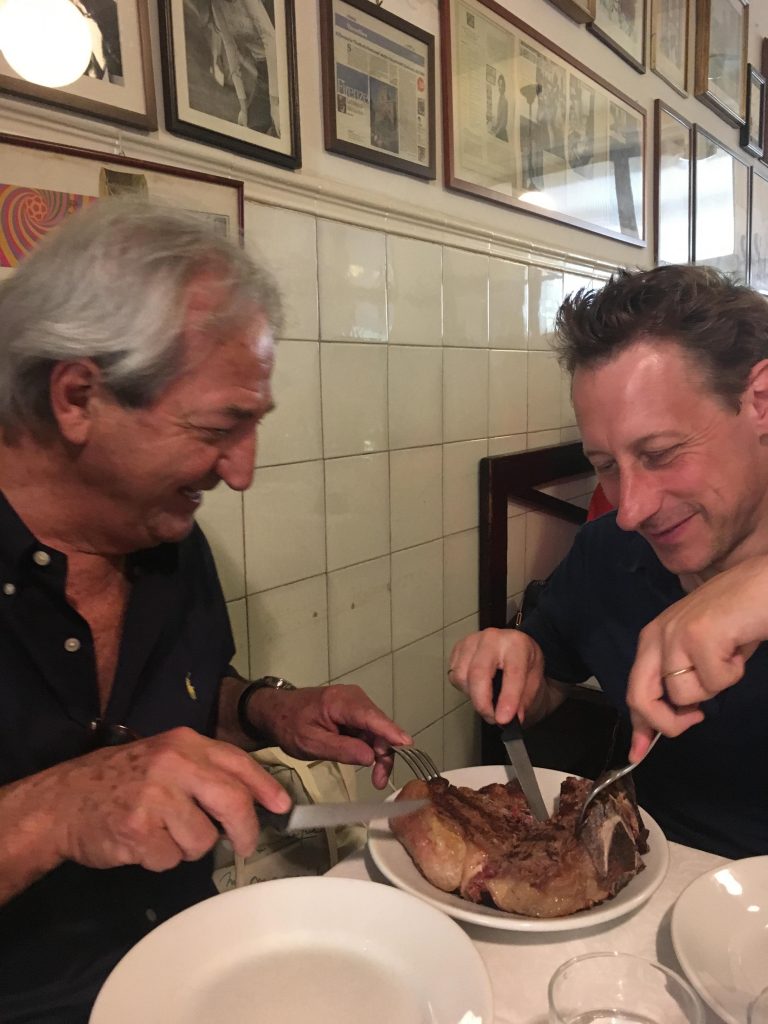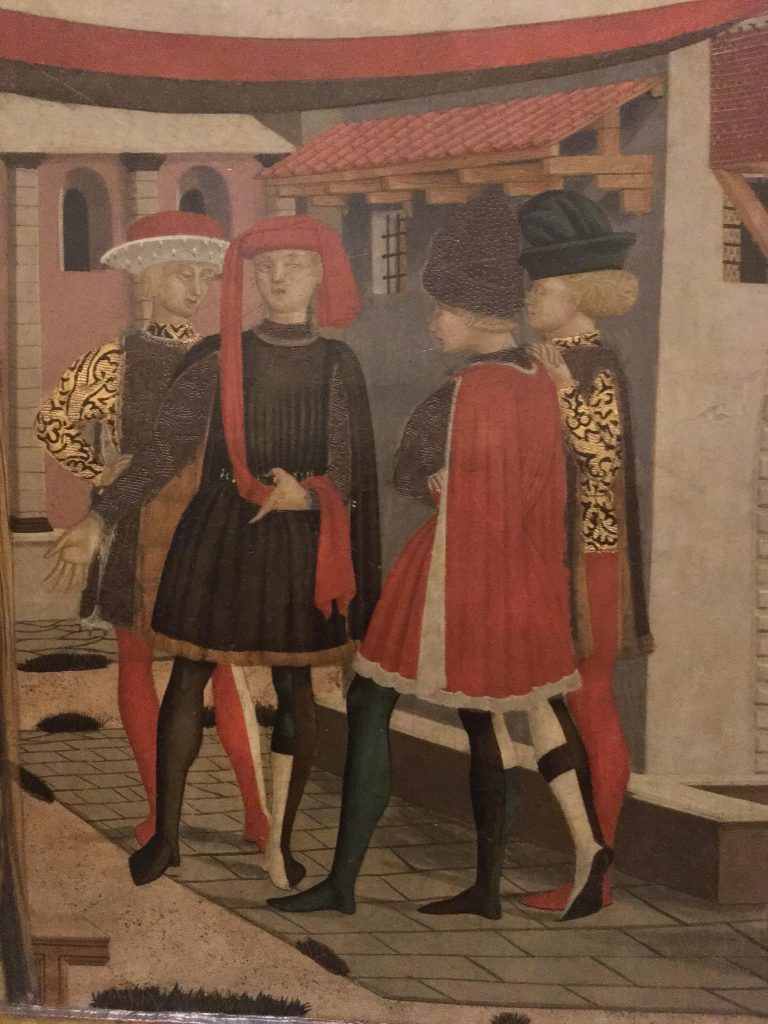We have just returned from a family wedding in Florence. Every time I visit Italy, I truly feel there is no country more beautiful. Rome will always remain my favourite, but nothing else matches Florence. The birth place of Renaissance. The Florentines must have an inner glow of cultural confidence knowing that it is their background.
Love and all that is beautiful in Florence.
23 June 2017

It was wonderful to be able to introduce my children to Renaissance art and the most iconic examples of western art.

Ancient Fresco’s in the Santa Maria di Novella.
Art of course comes hand in hand with its patron and much of what can be seen today lies in thanks to one family: the Medici’s. The largest Banking dynasty in Europe who put Florence on the map.

The 14th century crests of the most significant ‘Firenze’ families includes the Medici clan’s symbol of power: the six medicine balls. Their motto was make haste slowly and haste they did, becoming the banking capital of Italy and one of the wealthiest families in Europe. You could say the biggest accomplishment of the Medici’s was in the sponsorship of art and architecture. Due to their wealth and power they were responsible for the majority of Florentine art during their patronage.

The statue of Giovanni Caccini’s (1565-1613) Hercules and Nessus. During the 16th and 17th centuries, the Uffizi became known as the Gallery of statues.
Florence the city of cupolas and coloured marbles. Where ‘modern’ is 17th century and Brunelleschi’s forty five metre diameter Dome of the Cattedrale di Santa Maria del Fiore is forever in view. No one had ever built anything like this. The Medici’s wanted to put Florence on the map, as Pisa had done centuries before with the cathedral, baptistery and the tower.
It was the architectural contest of the 15th century. The leading architects of the age came up with their best ideas for a shot at fame forever and two hundred gold florins but it was a goldsmith who had never built anything before who became the most celebrated architect of all.

It was an extraordinary feat, especially as Brunelleschi had no architectural training. Quite unbelievable to consider it was completed in 1436, the largest cupola on earth, 272 years before St. Paul’s dome in 1708. Next time I will defy my fear of heights and go on a tour inside the dome.
The most important visits for me are not just the cultural but also the culinary. When I’m in Florence I have to visit my favourite restaurant Trattoria Sostanza that my best friend Naj introduced me to.

Knowing I would be there, Naj surprised me in the restaurant, driving two hours from Reggio to have lunch with me! As always we had great time reminiscing over old times and eating the specialities of the family owned restaurant with the original 1940’s tiles and framed memorabilia.

And then it was time to be amazed at the personification of wealth and power of the Medici collections at the Uffizi with almost hundred and fifty rooms filled with masterpieces from the 12th to the 18th century including Greek and Roman works of art. In the 18th Century, when there was no heir to continue the Medici line, everything the Medici family owned was left to the City on the premise that no pieces would ever leave and always benefit the inhabitants and visitors. I’m so grateful that they did.

1st century BC, Boy with Thorn ( also known as Spinario)
Bottechelli’s Birth of Venus, Da Vinci’s Annunciation and works by Giotto, Michaleangelo, Caravaggio and Raphael. The masterpieces are endless.

Detail taken of Leonardo da Vinci’s 1472 Annunciation.
From the Uffizi I could see where the pre-wedding celebrations would begin. In the rowing club overlooking one of the oldest bridges in the world, the 14th Century Ponte Vecchio which luckily still stand today. It’s hard to imagine that all the other bridges in Florence were destroyed in the WWII when the Germans were retreating; but the story goes that Hilter gave an order to save the Ponte Vecchio.

The sun sets on the River Arno.

The next day in between huge queues ( pre booked tickets next time) and the wedding, we were able to steal memorable moments of time with one of the greatest works of art, Michelangelo’s David.

The Medici family educated Michelangelo. The original and magnificent 5 m 17 David was created between 1501 and 1504 and is housed in the Academia Galleria alongside many others of his sculptures.

The treasures are endless, including 19th century plaster busts and ancient frescos from the 14th century.

15th century Annunciation. Painter Unknown.
We were also able to spend some time in the Santa Maria di Novella: the first great Basilica in Florence. To see the ancient Gothic and early Renaissance frescoes and the stripe pilasters designed by Leon Battista Alberti always amazes and inspires me.


I will forever be humbled and so grateful to be able to visit these magnificent works. There is always so much more to see and learn; however many times you visit. Luckily the National Gallery has a new show “Giovanni da Rimini’ early 14th Century masterpieces, which has been reviewed as ‘an exquisite little exhibition of exquisite little objects’ which I look forward to visiting.

Ancient Frescos in the Santa Maria di Novella.



